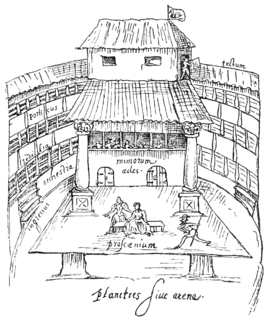 W
WThe American Shakespeare Center (ASC) is a regional theatre company located in Staunton, Virginia, that focuses on the plays of William Shakespeare; his contemporaries Ben Jonson, Beaumont and Fletcher, Christopher Marlowe; and works related to Shakespeare, like James Goldman's The Lion in Winter and Bob Carlton's Return to the Forbidden Planet.
 W
WThe Clifton Star Chamber Case or Clifton vs. Robinson was a court case of early modern England, in 1601, before the Star Chamber, concerning the abduction of children by choir schools.
 W
WThe Duke's Company was a theatre company chartered by King Charles II at the start of the Restoration era, 1660. Sir William Davenant was manager of the company under Prince James, Duke of York's patronage. During this period, theatres began to flourish again after being closed due to restrictions throughout the English Civil War and Interregnum. The Duke's Company existed from 1660 until 1682 when it merged with the King's Company to form the United Company.
 W
WEnglish Renaissance theatre, also known as Renaissance English theatre and Elizabethan theatre, refers to the theatre of England between 1558 and 1642.
 W
WA groundling was a person who visited the Red Lion, The Rose, or the Globe theatres in the early 17th century. They were too poor to pay to be able to sit on one of the three levels of the theatre. If they paid one penny, they could stand in "the pit", also called "the yard", just below the stage, to watch the play. Standing in the pit was uncomfortable, and people were usually packed in tightly. The groundlings were commoners who were also referred to as stinkards or penny-stinkers. The name 'groundlings' came about after Hamlet referenced them as such when the play was first performed around 1600. At the time, the word had entered the English language to mean a small type of fish with a gaping mouth - from the vantage point of the actor playing Hamlet, set on a stage raised around 5 feet (1.5 m) from the ground, the sea of upturned faces may have looked like wide-mouthed fish. They were known to misbehave and are commonly believed to have thrown food such as fruit and nuts at characters / actors they did not like, although there is no evidence of this. They would watch the plays from the cramped pits with sometimes over 500 people standing there.
 W
WThe intermedio [interˈmɛːdjo], in the Italian Renaissance, was a theatrical performance or spectacle with music and often dance, which was performed between the acts of a play to celebrate special occasions in Italian courts. It was one of the important predecessors to opera, and an influence on other forms like the English court masque. Weddings in ruling families and similar state occasions were the usual occasion for the most lavish intermedi, in cities such as Florence and Ferrara. Some of the best documentation of intermedi comes from weddings of the House of Medici, in particular the 1589 Medici wedding, which featured what was undoubtedly both the most spectacular set of intermedi, and the best known, thanks to no fewer than 18 contemporary published festival books and sets of prints that were financed by the Grand Duke.
 W
WIn March 1698, Jeremy Collier published his anti-theatre pamphlet, A Short View of the Immorality and Profaneness of the English Stage; in the pamphlet, Collier attacks a number of playwrights: William Wycherley, John Dryden, William Congreve, John Vanbrugh, and Thomas D’Urfey. Collier attacks rather recent, rather popular comedies from the London stage; he accuses the playwrights of profanity, blasphemy, indecency, and undermining public morality through the sympathetic depiction of vice.
 W
WSpanish Golden Age theatre refers to theatre in Spain roughly between 1590 and 1681. Spain emerged as a European power after it was unified by the marriage of Ferdinand II of Aragon and Isabella I of Castile in 1469 and then claimed for Christianity at the Siege of Granada in 1492. The sixteenth and seventeenth centuries saw a monumental increase in the production of live theatre as well as in the importance of the arts within Spanish society.
 W
WLa troupe du Roi de Suede, or Roi de Suede for short, was a French-speaking Swedish court theater, active at the Royal Swedish court from 1699 until 1706.